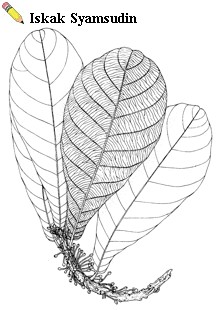Record Number
3667
PROSEA Handbook Number
5(1): Timber trees; Major commercial timbers
Taxon
Palaquium philippense (Perrottet) C. Robinson
This article should be read together with the article on the genus: Palaquium in the Handbook volume indicated above in this database.
This article should be read together with the article on the genus: Palaquium in the Handbook volume indicated above in this database.
Protologue
Philipp. Journ. Sc. 3: 304 (1908).
Synonyms
Madhuca philippensis (Perrottet) Baehni (1965).
Vernacular Names
Philippines: malak-malak (Tagalog, Pampangan), dalakan (Iloko), manogtalisai (Panay Bisaya).
Distribution
The Philippines (Luzon, Leyte, Mindoro, Panay, Negros, Mindanao).
Uses
The timber is used as nyatoh for furniture and cabinet making, cigar boxes and ship planking. The fruit is edible. The seeds yield an oil which is used for illumination or for cooking.
Observations
A medium-sized tree up to 25 m tall, with bole up to 80(—120) cm in diameter; leaves clustered at tip of twigs, obovate, narrowly obovate to spatulate, with inconspicuous transverse tertiary venation, densely yellowish-brown hairy beneath; flowers in 4—7-flowered clusters, borne on 13—45 mm long pedicels, greenish-yellow or greenish-white; fruit ellipsoid, c. 3 cm long, glabrous and green. Palaquium philippense is common in primary forests at low and medium altitudes. The heartwood is reddish-brown, with a density of 440—610 kg/m3 at 15% moisture content. The timber is traded as 'red nato', together with other Palaquium species, and is obtainable in limited quantities; it is moderately strong, easy to work, but very perishable when exposed to the weather or in contact with the ground.
Image
 | Palaquium philippense (Perrottet) C. Robinson - flowering twig and leaf showing tertiary venation |
Selected Sources
[36]Baehni, C., 1965. Mémoires sur les Sapotacéees 3. Inventaire des genres. Boissiera 11: 1–262.
[175]de Guzman, E, R. M. Umali, & E.D. Sotalbo, 1986. Guide to Philippine flora and fauna. Vol. 3: dipterocarps, non-dipterocarps. Natural Resources Management Center, Ministry of Natural Resources & University of the Philippines, Manila. xx + 414 pp.
[451]Mansfeld, R. & Schultze-Motel, J., 1986. Verzeichnis landwirtschaftlicher und gärtnerischer Kulturpflanzen [List of cultivated agricultural and garden plants]. 2nd ed. 4 volumes. Springer Verlag, Berlin. 1998 pp.
[480]Meniado, J.A., 1980. About the wood nato. Forpride Digest 9(1): 19–34.
[484]Meniado, J.A. et al., 1975–1981. Wood identification handbook for Philippine timbers. 2 volumes. Government Printing Office, Manila. 370 & 186 pp.
[486]Merrill, E.D., 1923–1926. An enumeration of Philippine flowering plants. 4 volumes. Bureau of Printing, Manila.
[579]Reyes, L.J., 1938. Philippine woods. Technical Bulletin No 7. Commonwealth of the Philippines, Department of Agriculture and Commerce. Bureau of Printing, Manila. 536 pp. + 88 plates.
[743]van Slooten, D.F., 1949. Sertulum dipterocarpacearum Malayensium IV. Bulletin of the Botanical Garden, Buitenzorg, Ser. 3, 18: 229–269.
[175]de Guzman, E, R. M. Umali, & E.D. Sotalbo, 1986. Guide to Philippine flora and fauna. Vol. 3: dipterocarps, non-dipterocarps. Natural Resources Management Center, Ministry of Natural Resources & University of the Philippines, Manila. xx + 414 pp.
[451]Mansfeld, R. & Schultze-Motel, J., 1986. Verzeichnis landwirtschaftlicher und gärtnerischer Kulturpflanzen [List of cultivated agricultural and garden plants]. 2nd ed. 4 volumes. Springer Verlag, Berlin. 1998 pp.
[480]Meniado, J.A., 1980. About the wood nato. Forpride Digest 9(1): 19–34.
[484]Meniado, J.A. et al., 1975–1981. Wood identification handbook for Philippine timbers. 2 volumes. Government Printing Office, Manila. 370 & 186 pp.
[486]Merrill, E.D., 1923–1926. An enumeration of Philippine flowering plants. 4 volumes. Bureau of Printing, Manila.
[579]Reyes, L.J., 1938. Philippine woods. Technical Bulletin No 7. Commonwealth of the Philippines, Department of Agriculture and Commerce. Bureau of Printing, Manila. 536 pp. + 88 plates.
[743]van Slooten, D.F., 1949. Sertulum dipterocarpacearum Malayensium IV. Bulletin of the Botanical Garden, Buitenzorg, Ser. 3, 18: 229–269.
Author(s)
R.H.M.J. Lemmens
Correct Citation of this Article
Lemmens, R.H.M.J., 1993. Palaquium philippense (Perrottet) C. Robinson. In: Soerianegara, I. and Lemmens, R.H.M.J. (Editors): Plant Resources of South-East Asia No 5(1): Timber trees; Major commercial timbers. PROSEA Foundation, Bogor, Indonesia. Database record: prota4u.org/prosea

All texts are licensed under a Creative Commons Attribution-Noncommercial-Share Alike 3.0 Netherlands License
This license does not include the illustrations (Maps,drawings,pictures); these remain all under copyright.